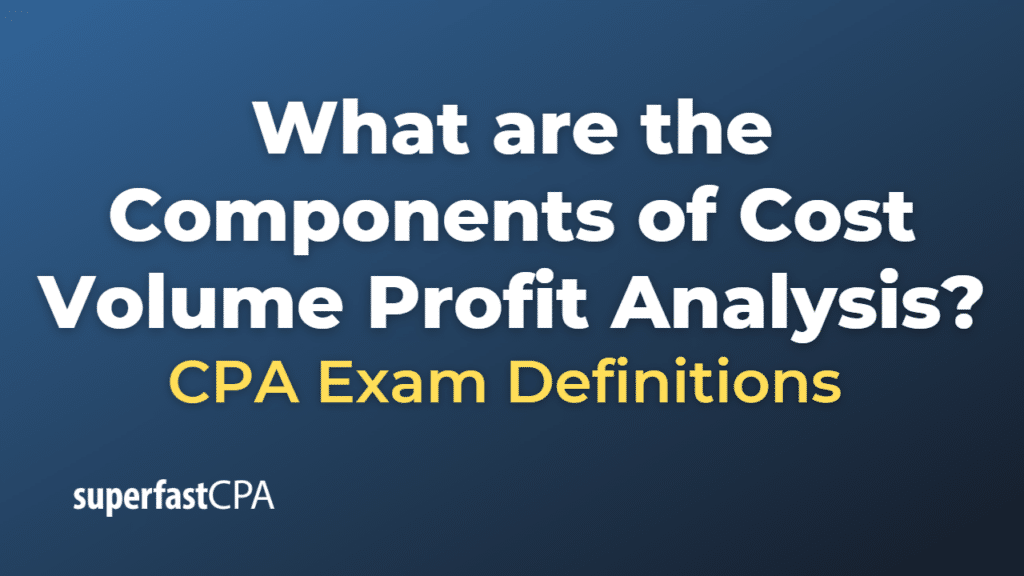Components of Cost Volume Profit Analysis
Cost-Volume-Profit (CVP) Analysis is a financial management tool that helps businesses understand the relationship between costs, sales volume, and profit. It is used to analyze the effects of changes in sales volume, production costs, and selling prices on a company’s profitability. CVP Analysis is particularly useful for decision-making purposes, such as pricing strategies, product mix decisions, and break-even analysis.
The key components of Cost-Volume-Profit Analysis include:
- Fixed Costs: Fixed costs are expenses that do not change in total as the sales volume or production level changes, at least within a relevant range of activity. These costs are incurred regardless of the number of units produced or sold. Examples include rent, salaries, insurance, and depreciation.
- Variable Costs: Variable costs are expenses that change in direct proportion to changes in the sales volume or production level. These costs vary based on the number of units produced or sold. Examples include direct materials, direct labor, and variable overhead costs like utilities and commissions.
- Contribution Margin: The contribution margin is the difference between the sales revenue and the variable costs. It represents the amount of money available to cover fixed costs and contribute to profit after accounting for variable costs. The contribution margin can be expressed on a per-unit basis (contribution margin per unit) or as a ratio (contribution margin ratio).
- Sales Revenue: Sales revenue is the total amount of money generated from selling goods or services. It is calculated by multiplying the number of units sold by the selling price per unit.
- Break-even Point: The break-even point is the level of sales at which total revenues equal total costs (both fixed and variable). At this point, the company neither makes a profit nor incurs a loss. The break-even point can be expressed in terms of units (break-even units) or sales revenue (break-even sales revenue).
- Target Profit: Target profit is the desired level of profit that a company aims to achieve. It can be used to determine the required sales volume or revenue to reach a specific profit goal, considering the fixed costs, variable costs, and contribution margin.
By understanding and analyzing these components, businesses can make informed decisions regarding pricing, production levels, cost control, and other strategic initiatives to optimize their profitability. CVP Analysis helps companies identify their break-even point, evaluate the impact of changes in sales volume or cost structure, and determine the sales volume needed to achieve a desired level of profit.
Example of the Components of Cost Volume Profit Analysis
Let’s consider a hypothetical example of a company, PrintCo, which manufactures and sells custom-printed T-shirts. PrintCo wants to use Cost-Volume-Profit (CVP) Analysis to better understand its business and make informed decisions. Here’s the relevant information for PrintCo:
- Fixed Costs: PrintCo has fixed costs of $10,000 per month, which includes rent, equipment depreciation, and salaries.
- Variable Costs: The variable cost per T-shirt is $5, which includes direct materials, direct labor, and variable overhead costs like utilities and shipping.
- Selling Price: PrintCo sells each custom-printed T-shirt for $15.
Now, let’s analyze the key components of CVP Analysis for PrintCo:
- Contribution Margin:
- Contribution Margin per Unit = Selling Price per Unit – Variable Cost per Unit
- Contribution Margin per Unit = $15 – $5 = $10 per T-shirt
- Contribution Margin Ratio:
- Contribution Margin Ratio = (Contribution Margin per Unit) / (Selling Price per Unit)
- Contribution Margin Ratio = $10 / $15 = 0.67 or 67%
- Break-even Point:
- Break-even Point (in units) = Fixed Costs / Contribution Margin per Unit
- Break-even Point (in units) = $10,000 / $10 = 1,000 T-shirts
- Break-even Point (in sales revenue) = Fixed Costs / Contribution Margin Ratio
- Break-even Point (in sales revenue) = $10,000 / 0.67 = $14,925
This means that PrintCo must sell 1,000 T-shirts per month or generate $14,925 in sales revenue to cover its fixed and variable costs, and to break even. Any sales beyond the break-even point will contribute to the company’s profit.
- Target Profit:
- Let’s assume PrintCo wants to achieve a target profit of $5,000 per month. To calculate the required sales volume to achieve this target profit, we can use the following formula:
- Required Sales Volume (in units) = (Fixed Costs + Target Profit) / Contribution Margin per Unit
- Required Sales Volume (in units) = ($10,000 + $5,000) / $10 = 1,500 T-shirtsc. Required Sales Revenue = (Fixed Costs + Target Profit) / Contribution Margin Ratio
- Required Sales Revenue = ($10,000 + $5,000) / 0.67 = $22,388
To achieve a target profit of $5,000 per month, PrintCo needs to sell 1,500 T-shirts or generate $22,388 in sales revenue.
By using CVP Analysis, PrintCo can better understand the relationship between its costs, sales volume, and profit, enabling the company to make informed decisions about pricing, production levels, and cost control to optimize its profitability.













